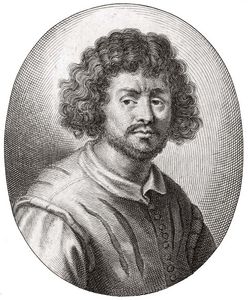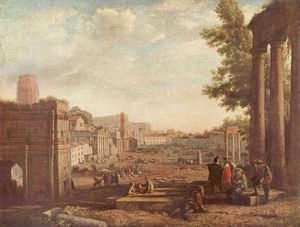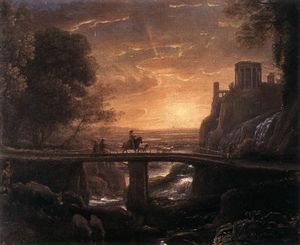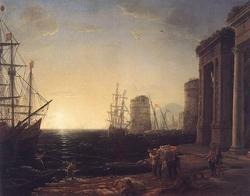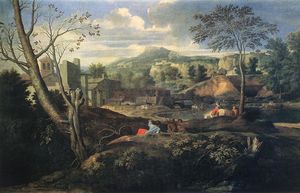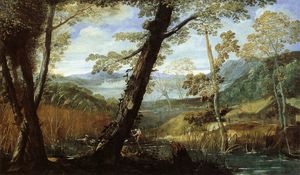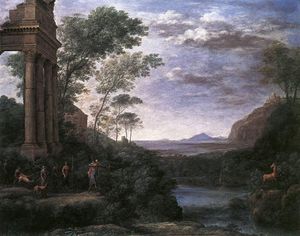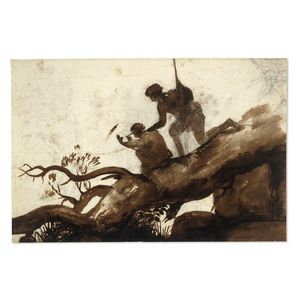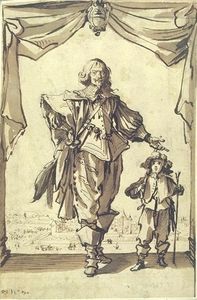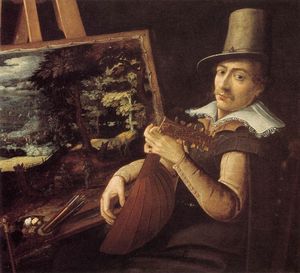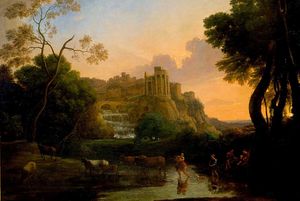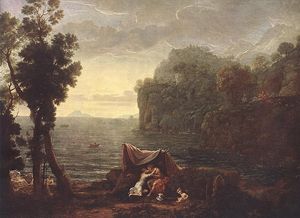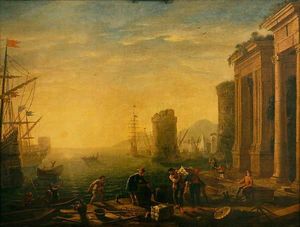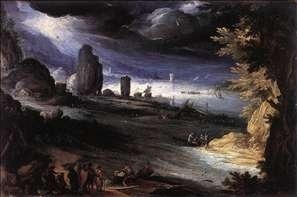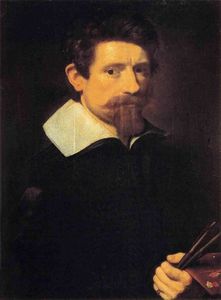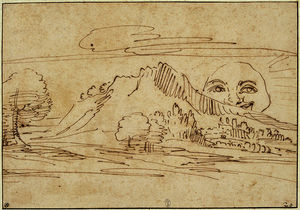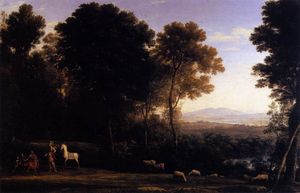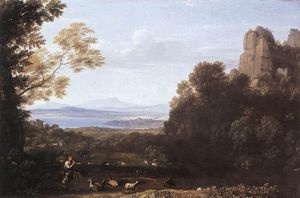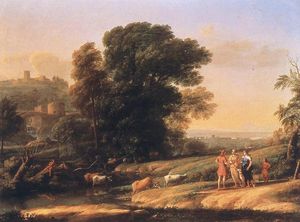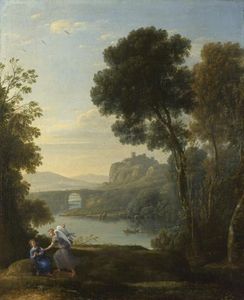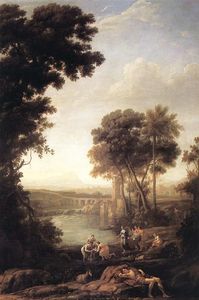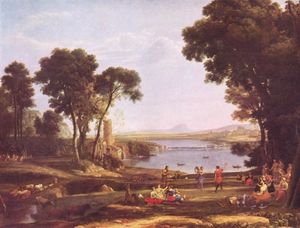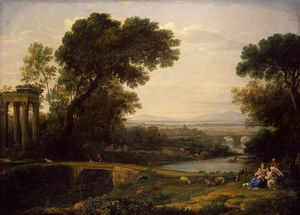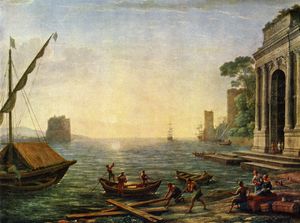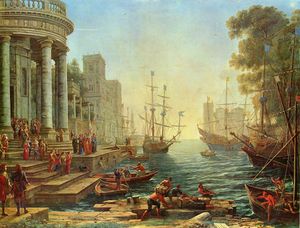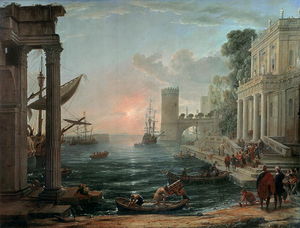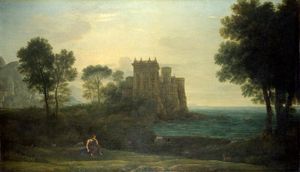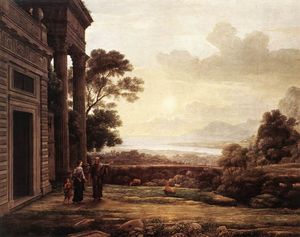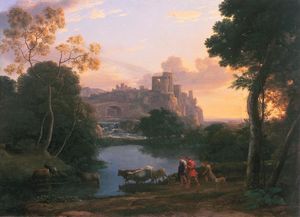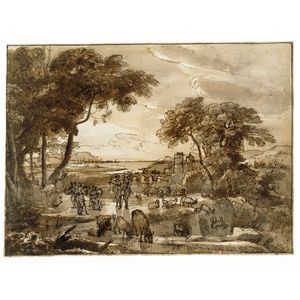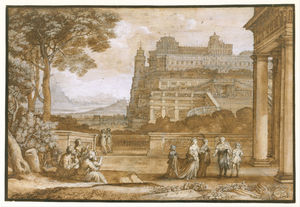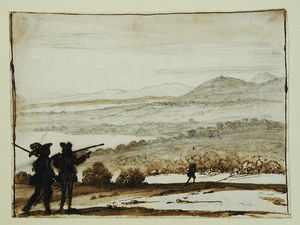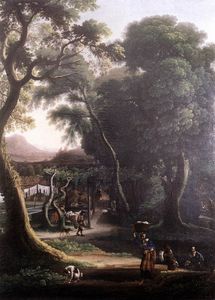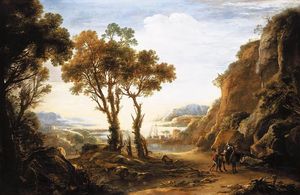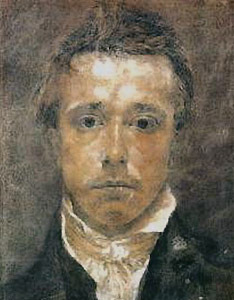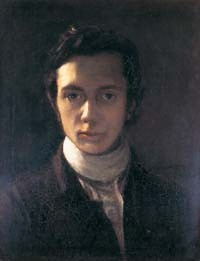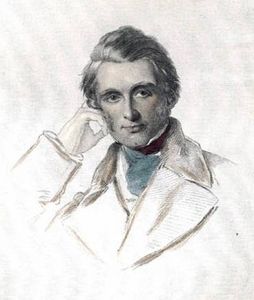Claude Lorrain
- Short Name:
- Lorrain
- Alternative Names:
- Claude Gellée, dit le Lorrain
- Date of Birth:
- circa 1605
- Date of Death:
- 23 Nov 1682
- Focus:
- Paintings, Drawings
- Mediums:
- Oil, Wood, Other
- Subjects:
- Landscapes
- Art Movement:
- Baroque
- Hometown:
- Chamagne, France
Introduction
Claude Lorrain's eerily beautiful landscape paintings have enchanted the art-loving public for centuries, making this French painter one of the most widely beloved artists of the Baroque. Building on the base of the ideal landscape created by his predecessors and contemporaries, particularly early Italian Baroque painter Annibale Carracci, fellow French Baroque painter Nicolas Poussin and Paul Bril, Claude Lorrain was perhaps the most influential landscape painter in the history of art and paved the way for generations of landscape painters to come.
Claude had some immediate followers in Italy and France in the late 17th and early 18th centuries (most notably his pupil, Angeluccio, Salvatore Rosa, and Claude Joseph Vernet), but Claude's greatest influence was felt in England. Claude's paintings impacted all aspects of English culture, from literature to garden design, and English artists were by no means immune to this influence. Claude's most important English disciples include the phenomenal Romantic artists J. M.W. Turner, John Constable, and Samuel Palmer.
Furthermore, Claude Lorrain was an absolutely superior draftsman, and in fact his paintings have on occasion inspired less interest than his free, spontaneous sketches of nature. Over 1,000 extant drawings have been attributed to the artist. These drawings range from extemporaneous sketches drafted on the spot during Claude's youthful romps through the fields surrounding roam, to carefully planned preparatory drawings for final compositions.
Some of Claude's most interesting drawings include those he executed for his famous Liber Veritatis, or Book of Truth. Claude began keeping this sketchbook around 1635 in an effort to keep the forgers of his work at bay. The Liber Veritatis was the first document of its kind in the history of art, and has enormous historical as well as aesthetic value.
Claude Lorrain Artistic Context
Claude Lorrain was one of the great painters of the French Baroque. Like his contemporary and close friend Nicolas Poussin, however, Claude actually spent the majority of his life and career in Rome, not in France; nonetheless, Claude's early childhood in the tumultuous region of la Lorraine would undoubtedly have had an affect on the artist. Along with Poussin, Claude helped to define the classicizing tendencies of French Baroque art.
Claude Lorrain's paintings are absolute points of reference in the genre of landscape. Building on the foundation laid for him by artists like Titian, Paul Bril and Annibale Carracci, Lorrain was the bold leader of the 17th century ideal landscape. Although landscape painting was long perceived as a "lesser" genre, Claude Lorrain achieved enormous success in his own lifetime, and continued to exert a powerful influence on French and English painting for centuries after his death.
The casual observer may assume that all of Claude's paintings are more or less the same; they are all landscapes, after all. A closer look, however, will reveal that there was a real evolution both in the style and composition of Claude's paintings throughout his career.
Claude's style and subjects are perhaps more consistent throughout his oeuvre than those of virtually any other artist, but that is not to say that there is no evolution in Claude's paintings. On the contrary, a careful look at Claude's paintings will reveal a rather surprising artistic journey.
Claude's early paintings are steeped in the northern European landscape tradition, complete with charming picturesque details and compositional surprises. As is unsurprising for an artist who studied and worked in Rome, however, as Claude matured his paintings became increasingly classical in tone and theme. The later paintings are cooler and more idealized, and exude a more melancholy, wistful atmosphere than the more cheerful, bustling early pictures.
Claude Lorrain Biography
Early Years:
Claude Lorrain was born into a poor peasant family in the Lorraine region, which today is located in northeast France. During Claude's lifetime, however, la Lorraine was still an independent region and his childhood would have been marred by the mounting hostilities with invading France.
Claude's parents, Jean and Anne Gellée, were the owners of a small plot of land and were unable to give their young son the academic education that other artists of his generation enjoyed; for his entire life, Claude would have difficulty reading, writing and doing simple calculations.
Claude's biographer states that the young man first got his training not in the art of painting, but in the art of pastry; young Claude was initially apprenticed to a pastry cook. At the tender age of 13, the boy decided to take his chance in the big city.
Claude arrived in Rome probably around 1617, where he initially found employment in a culinary capacity. A talent for drawing and painting must have quickly been discovered, however, because by the next year Claude had moved to Naples to study under a successful German artist. Thus began an artistic peregrination: Claude went from Naples back up to France to study under the successful Mannerist artist Claude Deruet, and then winding up back in Rome by 1626.
Middle Years:
Landscape painting business was booming in Rome during the mid-century. Luckily for Claude, Rome's reigning king of the landscape, the Flemish Baroque painter Paul Bril, had recently passed away, leaving some very enviable shoes to fill.
Claude spent his early 20s roaming the Roman countryside, making prodigious amounts of sketches. These sketches were the basis for oil paintings which he would complete in his studio. Claude was as busy as any of the top artists of the century, garnering top commissions from aristocrats, popes, and the King of Spain Philip IV, putting the humble Claude on the same level as the noble Velázquez.
In his 40s Claude became increasingly solitary. He no longer allowed other artists to visit his workshop, most likely as a result of a sudden rash of imitations and forgeries of his paintings that were flooding the market.
Advanced Years:
The artist never married and kept a small household, but he did adopt a young girl named Agnès in 1658 (some hypothesize that the girl may have been Claude's own illegitimate daughter). In addition to Agnès, Claude enjoyed the company of his pupil Angeluccio, and also opened his home to two of his nephews as he began to suffer from debilitating arthritis. Despite his illness, Claude enjoyed a long life, finally passing away in 1682.
Claude Lorrain Style and Technique
Claude Lorrain's paintings are perfect examples of the genre known as the idealized landscape, a type of painting pioneered by artists like Annibale Carracci and Domenichino, and perfected by Claude and Poussin. Claude's landscapes are thus simultaneously rooted in a strong naturalism, but beautified and idealized; Claude never shows the world's harsh realities, but instead a perfect image of nature as it should be.
Especially in his mature period, Claude's paintings are also characterized by a strong classicism, as evidenced by the presence of ancient ruins and figures in antique togas. The dominating palette is one of blues, greens and grays. More important than anything else, however, is Claude's utter adoration of light; effects of lighting were of paramount importance to the artist, whose paintings are almost exclusively scenes of dawn or twilight, the most "poetic" times of day.
Methods:
The naturalism of Claude's style, especially during his early period, has its roots in close study from nature. These abundant landscape drawings not only give a fascinating glimpse into the artist's working methods, but are also beautiful works of art in their own right.
When executing the final painting, Lorrain employed the standard technique of first painting a white ground on the canvas, and then adding a second ground applied in layers of various thickness and various hues which would in turn influence the appearance of the final layers of paint.
The painter is famous for his brilliant blues, which were achieved by using ultramarine, the most expensive kind of pigment available (it was made from lapus lazali, a rare precious stone); few 17th century artists could afford to use this pigment to the extent that Claude did.
Finally, the artist would paint incredibly thin layers of paint over the prepared canvas, constantly varying his hues, shades and handling, thus creating an incredibly intricate and luminous pictorial surface.
Who or What Influenced Claude Lorrain
Claude Lorrain's luminous, hauntingly beautiful landscape paintings may be pioneering works of art in the genre of landscape, but Claude didn't get there alone. His style is the end result of years of study from the masters; Claude's major influences range from French and Italian contemporaries to the Venetian Renaissance.
Claude Déruet:
Claude studied in this painter's studio during the 1620s, when Déruet was the most successful painter in Lorraine. Déruet appears to have had a long-lasting influence on the young Claude Lorrain. Déruet painted in a strongly Mannerist style, and his elongated, fancifully dressed figures seem to have been the source of inspiration for Claude's curious depiction of the human figure.
Déruet enjoyed high favor with the French nobility; he was the Duke of Lorraine's official court painter, was made a noble in 1621, and was honored with knighthood in 1645 by King Louis XIII.
Paul Bril:
Originally from Antwerp, this wildly popular Flemish Baroque painter was the leading landscape painter in Rome for over forty years. His widely sought-after landscapes blend a northern dynamism and drama with an Italianate classicism.
Claude seems to have desired to fill the master's shoes as Rome's next great landscape painter after putting down roots in the city around 1626. Claude even went so far as to imitate Bril's practice of regularly signing (sometimes even dating) his paintings, which was still relatively unusual for the 17th century.
Adam Elsheimer:
This German painter of the early Baroque was enormously influential at the beginning of the 17th century, inspiring not only Claude Lorrain but also artists like Rembrandt and Rubens. Elsheimer's tiny, meticulously crafted paintings on copper plates reveal marvelous effects of light as well as stunning landscapes.
Titian:
This star of the Venetian Renaissance seems to have been the major influence for virtually all 17th century artists. In the background of his mythological scenes, Titian would paint lovely, idealized landscapes bathed in warm, golden light and receding believably into the background.
These paintings were enormously successful during Titian's own lifetime, and were the paintings of reference for all subsequent landscape painters, including Claude Lorrain.
Annibale Carracci:
This leading figure of the Italian Baroque was the pioneer of ideal landscape painting, and Carracci's paintings would exert a strong influence on Claude. Carracci's three-dimensional treatment of space, cool colors, calm mood, and classical idealism all found their way into Claude's style during the French artist's mature period.
Claude Lorrain Works
Claude Lorrain Followers
The resounding success of Claude's paintings during the 1630s and 40s inspired a bevy of imitators both locally and abroad. Local Roman artists continued in Claude's cool, classicizing vein, while Dutch and Flemish artists took Claude's style with them back up north, where it was blended with their own local painting traditions. Claude's immediate followers included;
Angeluccio:
Claude's only pupil (besides his faithful assistant, Giandomenico Desiderii), Angeluccio unfortunately died at a young age before his artistic skills reached maturity, leaving behind only 25 paintings and 35 drawings.
Angeluccio was heavily influenced by Claude particularly in terms of palette and structuring his compositions, but the younger artist also drew from diverse Northern and Italian sources as well. Angeluccio's style was thus not a mere imitation of the greater master, but a unique interpretation of the genre.
Salvatore Rosa:
Rosa was significantly influenced by his much tamer contemporary. Many art critics contend that Rosa's best works were in the genre of landscape, and although Rosa's landscapes are far moodier and more dramatic than Claude's, Rosa still owes a significant debt to the French painter's compositions.
French followers:
Claude Joseph Vernet:
Often described as "the French Claude" Vernet lived in Rome for 20 years and was particularly inspired by Claude's delicate, moving atmospheric effects.
English followers:
J. M.W. Turner:
This Romantic artist is widely regarded as the landscape painter of all time, perhaps even edging out Claude Lorrain in terms of historical significance. His work may seem worlds away from Claude's restrained classicism, but Turner was in fact deeply influenced by his predecessor, particularly Claude's overwhelming interest in atmosphere and the effects of light, interests which Turner shared.
John Constable:
Constable was first introduced to Claude Lorrain after collector George Beaumont showed Constable Claude's Hagar and the Angel. Claude's beautifully poignant, expressive paintings proved to be a major inspiration for the young Constable, who famously declared "painting is but another word for feeling."
Samuel Palmer:
Palmer is the third part of the triumvirate of English Romantic landscape painters, but his art differs significantly than that of Turner and Constable. Palmer's eerily gorgeous style may seem totally different from Claude's paintings, but just like the painters listed above, Palmer was deeply influenced by Claude's idealized, poetic visions of nature.
Claude Lorrain Critical Reception
For an artist who was so beloved during his own lifetime, and who exerted such a profound influence on subsequent generations of artists, Claude Lorrain's critical reputation has certainly suffered some hard knocks.
Early supporters were gushingly admiring of the painter and British philosopher William Hazlitt called him "the perfect painter".
Claude's biggest admirers were initially in England, where this French Baroque artist was perhaps more popular than anywhere else in Europe.
John Ruskin:
Claude Lorrain bore the brunt of Ruskin's wrath towards the baroque movement. Ruskin absolutely worshipped English Romantic painter J. M.W. Turner, who was ironically heavily influenced by Claude Lorrain, and the art critic used Claude as a foil against which his beloved Turner would shine all the brighter.
In his widely read Modern Painters of 1846, Ruskin accused Claude of being a wretched draftsman, having no emotion or sentiment, and being divorced from nature.
The 20th Century:
Claude Lorrain was more or less critically ignored until the mid-20th century, thanks in part to a critical love of artists like Turner and Constable, which rekindled critics' interest in their sources.
Marcel Roethlisberger was the first art historian to begin to restore Claude's reputation with the publication of two catalogue raisonnées in 1960 and 1968, and Roethlisberger remains one of the great Claude experts of the century. Today, exhibitions highlighting Claude's paintings abound, and the artist has justly earned the critical acclaim and public devotion that he so richly deserves.
Claude Lorrain Bibliography
To read more about Claude Lorrain please choose from the following recommended sources.
• Askew, Pamela, ed. Claude Lorrain: 1600-1682: a symposium. Washington: National Gallery of Art, 1984
• Grahame, George. Claude Lorrain, Painter and Etcher. Seeley and Co. , 1895
• Lagerlöf, Margaretha Rossholm Ideal Landscape: Annibale Carracci, Nicolas Poussin, and Claude Lorrain. Yale University Press, 1990
• Mannocci, Lino. The Etchings of Claude Lorraine. Yale University Press, 1988
• Rand, Richard. Claude Lorrain: The Painter as Draftsman. Yale University Press, 2007
• Röthlisberger, Marcel. Claude Lorrain: The Paintings. Hawker Art Books, 1979
• Russell, Helen Diane. Claude Lorrain, 1600-1682. Washington : National Gallery of Art, 1982
• Wine, H. Claude : The Poetic Landscape. London: National Gallery, 1994

